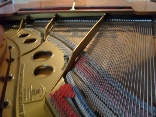






Complete the melody - Pitch the Melody
Now you have the upper and lower note limits, the phrase structure and an outline
rhythm, you’re ready to fill in and pitch all the notes of the melody. You may be
lucky enough to hear the opening 2 bars accurately and be inspired enough on the
day to come up with a completing tune. But in case you cannot “hear” the first two
bars, or lack confidence that you are pitching it correctly in your head, or you’re
simply too anxious to invent a melody, then follow the steps below. Remember the
examiners are not expecting inspired works of art - even if a budding Mozart wrote
an exemplary answer, it would not score more than an uninspired melody work to the
“formula” below. Marks cannot be given according to subjective aesthetic judgements.
The work you’ve done on chords and especially cadences will pay dividends now, since
you can map out your melody according to an underlying chord progression.
The first few chord notes of the opening bar will be taken from the I (tonic) chord
- don’t get distracted by intervening passing notes. This will confirm the scale/key
of the melody. You have four bars to go from the I (tonic) chord to the V (dominant)
chord that completes the imperfect cadence which ends the first phrase. This is NOT
a long span of music and should not contain more than 2 chord changes, so the chord
sequence for the first phrase could be any of :-
First phrase
I - IV -V - 3 chord progression
I-V-I-V I-V-II-V I-V-IV-V I-IV-I-V I-IV-II-V - 4 chord progression
If the opening given two bars only contain chord notes from the tonic chord, use
the I-IV-V progression by default. Quite often though the opening two bars has chord
notes implying a I-V progression, in which case complete the first phrase with the
default I-V-I-V progression. These default chord choices will establish a strong
sense of key around the tonic, which is all you should aim to do in 4 bars.
Second phrase
The should span no more than 4 chords with the final V-I perfect cadence occurring
quickly over the last 2 to 4 beats.
IV-V-I II-V-I VI-V-I - 3 chord progression
IV-II-V-I IV-VI-V-I II-IV-V-I . . . . - 4 chord progression
The short answer is “DON’T”
Looking at the model answers of the last 5 years, not one contained an established
key change,and 90%+ didn’t even hint at a key change.
You won’t get any extra marks for implying a key change and you might conceivably
lose points for trying to contrive a key change badly in the small span of 8 bars.
To play safe then all your melody notes should be taken from the scale indicated
by the key signature and the opening 2 bars.
If a MAJOR scale YOU SHOULD NOT HAVE ANY ACCIDENTALS!!
If a MINOR scale YOU NEED ACCIDENTALS as described in the next section
If you want to be more daring, the ideal place to hint a key change is the use
of a II-V chord progression for the imperfect cadence ending the first phrase. All
this entails is using the “major” chord on the II by “sharpening” with an accidental
the 4th note of the original scale.
E.g. in the key of C, the II chord is ordinarily D-F-A, but the major chord is D-F#-A.
If you use a F# in the melody, especially if it steps up to G, (the dominant) you
create a temporary sensation of being in the major scale of the dominant - pretty
much the only “key” change that could be safely negotiated in such a small span of
8 bars.
Major/Minor key considerations
MAJOR key - chords I,IV and V are all major so if you want to keep a “bright”
melody throughout, restrict your chords to these (which are the advised defaults)
Chords II and VI will introduce a minor sound, if that’s what you “hear”, provided
you use the minor 3rd interval of these chords very obviously.
MINOR key - the use of the V chord in the imperfect and perfect cadences will produce
a “major” sound only if you use and “sharpen” (with an accidental) the 7th note
of the minor scale.
Any time the melody runs up from the 7th tone to the 8th (the tonic), you must “sharpen”
the note with an accidental.
Since you are composing a melody, you should use the melodic minor scale - so in
upward runs of notes through the 6th-7th and 8th notes of the scale you should sharpen
the 6th and 7th notes with accidentals.
Notes running downwards through 8th-7th and 6th notes should follow the descending
melodic minor scale, using any accidentals required.


